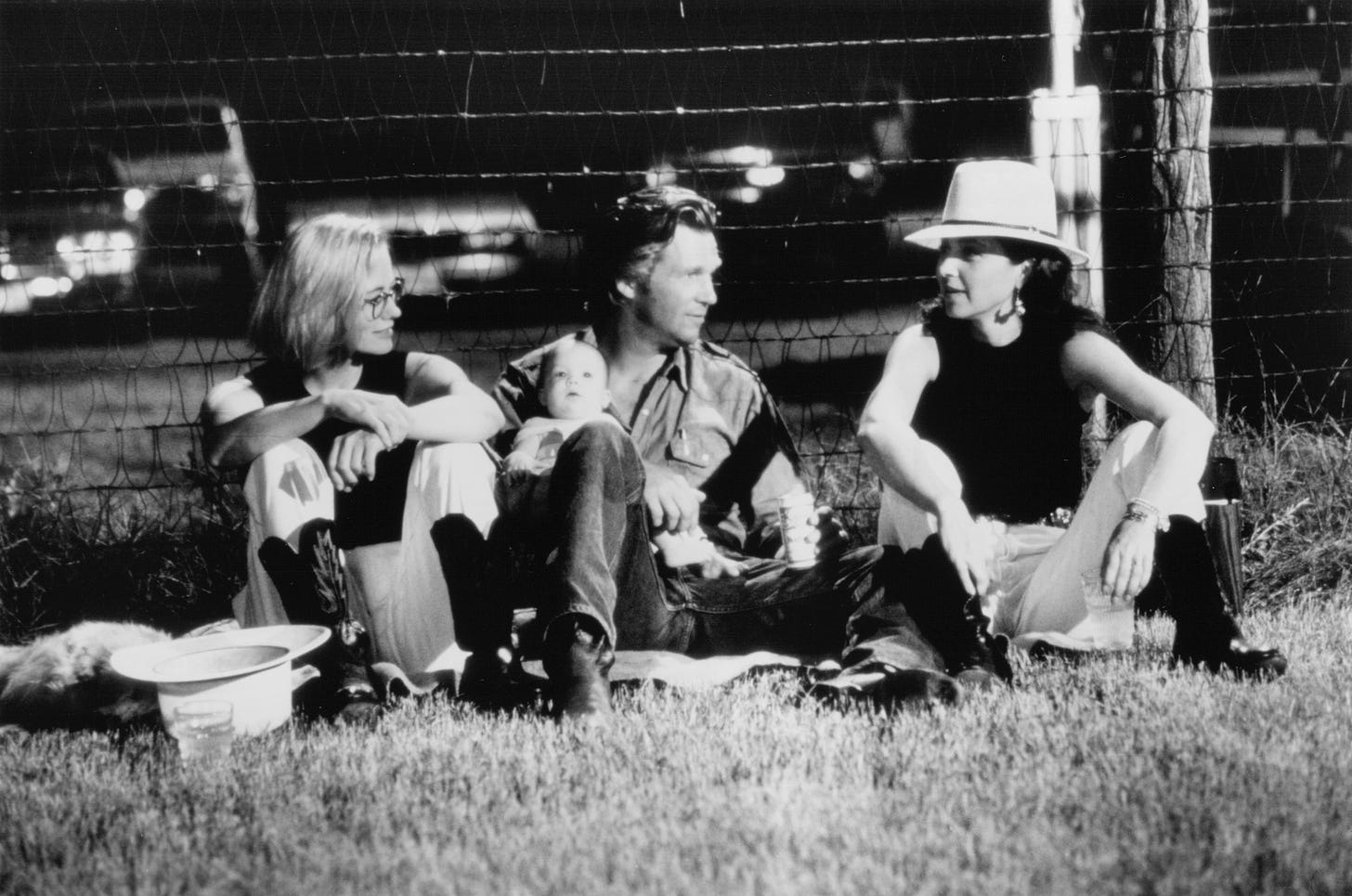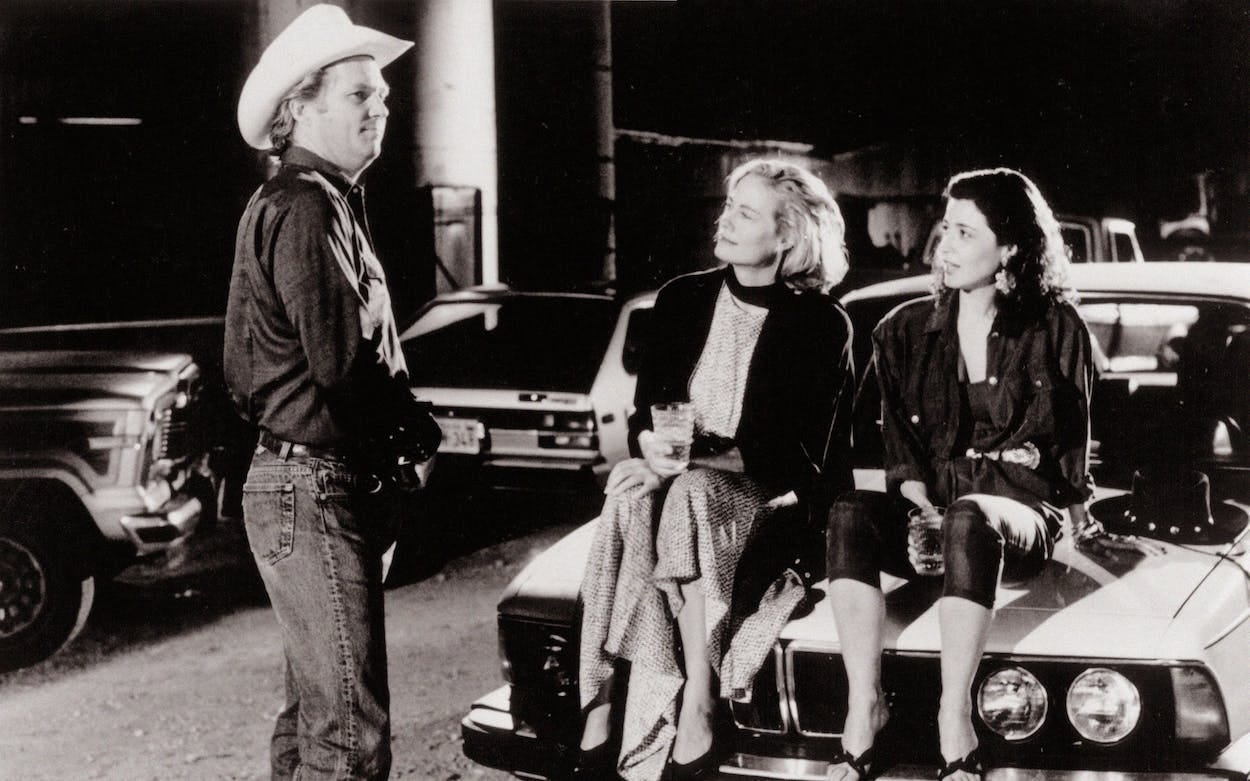Written on the Wind: The Director's Cut of 'Texasville'
The new Criterion edition of 'The Last Picture Show' includes a black-and-white cut of its 1990 sequel that's almost 30 minutes longer. It's worth a second look.
When the soundtrack of Peter Bogdanovich’s The Last Picture Show goes quiet—which is to say, when the dialogue and the steady diet of Hank Williams songs stop—the wind picks up, howling through the tiny town of Anarene, Texas. It’s a haunting noise, as if nature has come to reclaim this small flicker of civilization that is slowly and inexorably burning out. Perhaps there was once a time when downtown bustled with enough activity to mute the howls of the arid plains surrounding it, but once Sam “The Lion,” the owner of the pool hall, the café, and the movie theater, dies of a stroke, Anarene essentially dies with him. For the high school kids at its center, The Last Picture Show presents a grim coming-of-age: What’s it like to grow up in a place that has no future? Where do they go when home disappears?
At the end of the film, when Bogdanovich cranks up those howls and Robert Surtees’ camera scans the vacant streets and storefronts of Anarene, ending on The Royal theater with an empty marquee, it’s like you’re witnessing a loved one on hospice finally passing away. The three main characters have mostly scattered to these winds: Duane (Jeff Bridges) has left to nearby Odessa to take a job as a roughneck on an oil well, and the well-to-do Jacy (Cybill Shepherd) has gone to college in Dallas, leaving only Sonny (Timothy Bottoms) to sort through the wreckage, which for him starts with his ruptured affair with Ruth (Cloris Leachman), the lonely wife of the high school football coach. (Their final scene together, where she shows mercy on him for breaking her heart, is a stunner.) You leave the film assuming that Anarene is another Western boom town that’s now a ghost town.
And so 19 years later, when Bogdanovich and his actors returned to the same place for Texasville, a drama set 33 years after the events of The Last Picture Show, it seemed like a bizarre and unnecessary project, the very definition of an anticlimax. Only a month before Texasville was released, Jack Nicholson attempted his own belated sequel to a ‘70s classic by directing The Two Jakes, his follow-up to Chinatown, but even that misbegotten enterprise felt like it had some commercial juice, given Nicholson’s stardom and the evergreen appeal of private detective yarns. The town itself was the main character in The Last Picture Show, a true gravitational force, and we’d witnessed (or thought we’d witnessed) it disappear, so a sequel felt like hanging around after the party was over. Add to that the fact that Texasville was in color and that Bogdanovich’s career had been in steep decline, and it seemed like the opposite of promising.
And that was my reaction in 1990: Nope, this doesn’t work. That Texasville would lack the grace and the gravity of The Last Picture Show seemed inevitable, and without Anarene as an imposing, allegorical presence as an American city on the wane, the whole enterprise felt rudderless. It came and went quickly, opening to middling reviews and lousy box office, making only $2 million back off an $18 million budget. (Though how can you not smile at the thought of The Last Picture Show, of all movies, being considered a valuable piece of IP nearly two decades later? Especially since it had never been available on VHS!) Over the years, however, Texasville has found some defenders among the Bogdanovich faithful and the director himself had pressed for a wider release of a 1992 cut he put together for the Movie Channel, which ran 28 minutes longer and he felt better balanced its comedy and drama.
The new Criterion edition of The Last Picture Show includes Texasville as a supplemental feature, with both original theatrical cut (in color) and Bogdanovich’s two-and-a-half hour version in black-and-white. While I would not say the director’s cut is a revelation—the word “rudderless” still applies to much of it—it’s a significant improvement, a big-hearted and philosophical slice-of-life that at least justifies its existence. First and foremost, it’s a reminder that The Last Picture Show started as a novel by Larry McMurtry, the great chronicler of Old West and contemporary Texas, and so did Texasville, which McMurtry had written as a novel in 1987. Anelene hasn’t been wiped off the map, after all, but McMurtry’s characters are what drive this wisp of a narrative forward. He spins gentle tragicomedy out of the mess they’ve made of their lives.
While Surtees’ more textured and high-contrast photography is dearly missed from both cuts, the black-and-white of the director’s cut does provide more continuity between The Last Picture Show and Texasville. The film opens with Duane in a hot tub on his ranch, idly shooting holes in the dog house with his revolver. (This becomes a recurring theme. When Texans get bored, they turn to target practice.) Though the now-50-year-old Duane is the town’s improbable winner, an oil tycoon with a family as sprawling as his ranch home, his wells have all dried up and falling global oil prices have left him millions in debt and close to bankruptcy. His marriage to the spunky Karla (Annie Potts) is on perpetually shaky ground due to multiple affairs and his son Dickie (William McNamara) seems to be bedding all the women he hasn’t—and at least one that he has.
The arrival of Jacy, his high school sweetheart, makes the mess messier. She remains just as alluring as she was as the homecoming queen that wedged between Duane and best friend Sonny, and she’s more worldly and glamorous after traveling through Europe and nursing a career as an actress. But Jacy has returned to Anarene after the death of her only son and she carries that wound close to the surface, even as she gets entangled in Duane and Karla’s lives. Meanwhile, Sonny has not only stayed in town as a store clerk, but it’s as if time has frozen for him past 1951. In one scene, he wanders up to the roof of The Royal, which has rotted to its foundations, and looks lost in thought, still dreaming about the movies. “It’s like I’ve got this VCR and it’s in my brain,” he says later.
Texasville seems like the type of movie that exists more comfortably on the page, when an author of McMurtry’s talent can make readers content with following characters who are more or less running in place. That’s part of the point: Though the story builds to a centennial celebration, Anarene is not exactly thriving and so we’re still dealing with characters who are not on an upward trajectory. And if you’ve ever driven through middle America, you’ll see town after town with boarded-up shops and a conspicuously aging population, because such places are still home even as their best days are decades in the past. Other than preparing for this centennial—Duane and Jacy have agreed to play Adam and Eve in the pageant—Texasville has little plot and low stakes. If the time frame were shorter, it could fit right into the continuum of dusk-till-dawn hangout movies like American Graffiti or Dazed and Confused.
Bogdanovich arranges much of Texasville as a kind of screwball comedy in slow motion, like a trial run for his adaptation of Michael Frayn’s stage farce Noises Off two years later. Duane ping-pongs in and out of the arms of other women, getting himself in the middle of all sorts of marital dramas, and you get the sense that boredom, as much as lust, motivates the town’s general libidinousness. Karla doesn’t flinch much as her husband’s blatant infidelity—she has had an affair of her own, in fact—but there doesn’t seem to be much authentic hurt in their marriage until Jacy surfaces. Too many of the side relationships amount to static, along with the comic micro-dramas that swirl among Duane’s Lothario son and unruly extended family. Only in the climax, when his rascally twins take the initiative to marshal other children into stealing thousands of eggs from a truck and raining them down on the centennial celebration does the comedy really spring to life. (This is as close to the famed pie fight sequence in Dr. Strangelove that we’re ever likely to get.)
Texasville is better when it’s more sincere. For one, Bogdanovich preserves McMurtry’s extraordinary dialogue in his script, leading to often genuinely poetic reflective moments. Watching TV at a motel with Duane, Jacy responds to his dismissive attitude with a bit of profundity: “Game shows are what life’s really like,” she says. “You win things that look great at the time but turn out to be junk, and you lose things you might want to keep forever, just because you’re unlucky.” We expect the sparks to fly between Duane and Jacy, with poor Karla left in the cold, but their chemistry winds up informing a friendship that only seems like the patter of ex-lovers looking to rekindle the flame. Once again, Jacy puts it elegantly: “I know I flirted a little, but that’s just my nature. Actually, it’s just the ghost of my nature.”
One effect of the black-and-white Texasville is the reminder that The Last Picture Show, too, was loose-limbed and episodic, only it had the shuttering of the town itself as a hidden narrative engine. Bogdanovich has no such force here, so he brings all the major characters from both films—including Ruth, who now works as Duane’s loyal secretary—together for a manufactured crisis, with Sonny teetering atop a football bleachers in the midst of a sad reverie that could be fatal. And yet the sincerity of Bogdanovich and his cast’s feelings for these characters give it real emotional punch, as they all recognize together that they are Anarene, despite the town’s long-ago turn to economic ruin. The wind still howls in the final moments, just as it does in The Last Picture Show. But they’re not scattered by it.






